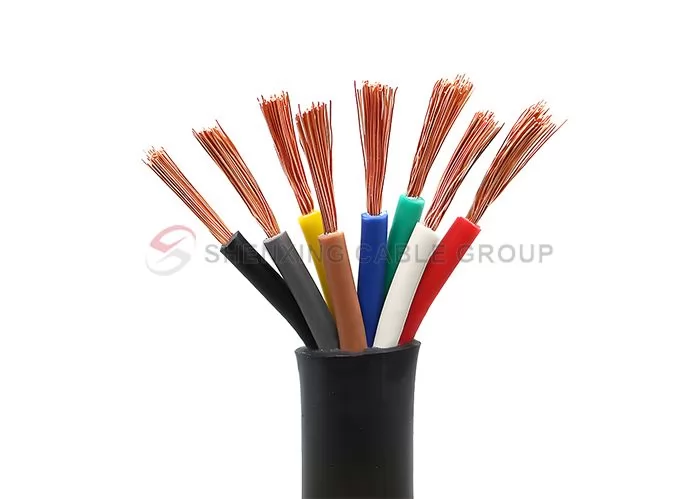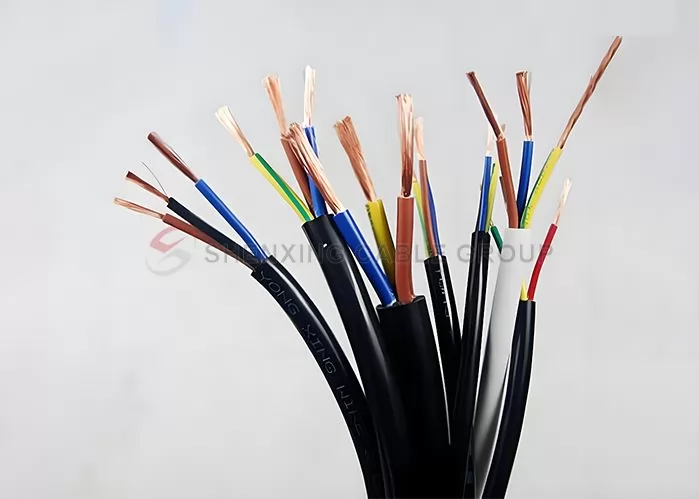+86 151 2718 0862
Lightweight PVC Sheathed Flexible Cable-RVV
RVV cable is called sheathed cable, which is a commonly used cable in weak current system. It has a rated voltage of 300V/500V, two or more conductor cores, and a PVC sheath layer on the outside. The main function of the sheath layer is to protect the cable from mechanical damage and chemical corrosion, and to enhance the mechanical strength of the wire, so it is called RVV cable.
RVV cable is suitable for a variety of application scenarios, including home power wiring, industrial equipment connections, office electrical systems, etc. Whether it is used for power transmission, electrical equipment connection, or use in harsh environments, RVV cables can provide stable, efficient, and safe power support.
Share:

Home power wiring
The high conductivity and safety of RVV cables ensure stable and reliable power support for daily life.
Office buildings and commercial buildings
RVV cables are commonly used in office power wiring and commercial building electrical systems to provide stable power supply for computer equipment, lighting, air conditioning, etc., and support the efficient operation of low-voltage electrical systems.
Industrial equipment connection
Especially for kinds of electronic installation of industrial condition.
Equipment connection and power transmission
Applicable to power connection of various low-voltage electrical equipment to ensure the stability of power transmission, especially in applications requiring electromagnetic compatibility (EMC) and anti-interference.

Reliable power transmission performance: high-quality copper conductors and PVC insulation materials are used to ensure stable power transmission.
Strong durability: with high tensile resistance and wear resistance, it can adapt to various complex environments, especially suitable for industrial equipment and production lines.
Flexible installation: the cable is soft and has a small bending radius, which is suitable for wiring in small spaces and easy to install and maintain.
RVV Cable Technical Data
Shenxing as a leading RVV cable supplier, we provide RVV cables with different configurations, including 3-core RVV cable, 2-core RVV cable, 4-core RVV cable and 5-core RVV cable, the following are the specific parameters
| Number of cores | Conductor diameter | Nominal cross section | Insulation thickness | Sheath thickness | Stranded conductor | ||
| Cable outer diameter lower limit | Cable outer diameter upper limit | Minimum insulation resistance at 70℃ | |||||
| (mm) | (mm²) | (mm) | (mm) | (mm) | (mm) | (MΩ/km) | |
| Two cores Rvv Cable | 0.8 | 0.5 | 0.5 | 0.6 | 4.6 or 3.0×4.9 | 5.9 or 3.7×5.9 | 0.012 |
| 1 | 0.75 | 0.5 | 0.6 | 4.9 or 3.2×5.2 | 6.3 or 3.8×6.3 | 0.01 | |
| 1 | 0.75 | 0.6 | 0.8 | 5.7 or 3.7×6.0 | 7.2 or 4.5×7.2 | 0.11 | |
| 1.1 | 1 | 0.6 | 0.8 | 5.9 or 3.9×6.2 | 7.5 or 4.7×7.5 | 0.01 | |
| 1.4 | 1.5 | 0.7 | 0.8 | 6.8 | 8.6 | 0.01 | |
| 1.8 | 2.5 | 0.8 | 1 | 8.4 | 10.6 | 0.09 | |
3 Cores Rvv Cable | 0.8 | 0.5 | 0.5 | 0.6 | 4.9 | 6.3 | 0.012 |
| 1 | 0.75 | 0.5 | 0.6 | 5.2 | 6.7 | 0.01 | |
| 1 | 0.75 | 0.6 | 0.8 | 6 | 7.6 | 0.11 | |
| 1.1 | 1 | 0.6 | 0.8 | 6.3 | 8 | 0.01 | |
| 1.4 | 1.5 | 0.7 | 0.9 | 7.4 | 9.4 | 0.01 | |
| 1.8 | 2.5 | 0.8 | 1.1 | 9.2 | 11.4 | 0.09 | |
| Four cores Rvv Cable | 1 | 0.75 | 0.6 | 0.8 | 6.6 | 8.3 | 0.11 |
| 1.1 | 1 | 0.6 | 0.9 | 7.1 | 9 | 0.01 | |
| 1.4 | 1.5 | 0.7 | 1 | 8.4 | 10.5 | 0.01 | |
| 1.8 | 2.5 | 0.8 | 1.1 | 10.1 | 12.5 | 0.09 | |
| Five cores Rvv Cable | 1 | 0.75 | 0.6 | 0.9 | 7.4 | 9.3 | 0.11 |
| 1.1 | 1 | 0.6 | 0.9 | 7.8 | 9.8 | 0.01 | |
| 1.4 | 1.5 | 0.7 | 1.1 | 9.3 | 11.6 | 0.01 | |
| 1.8 | 2.5 | 0.8 | 1.2 | 11.2 | 13.9 | 0.09 | |
Expand all
Only some product parameters are displayed. For more product information, please contact us.
The above parameters are for reference only.
Cable Structure
Light Duty PVC Insulated PVC Sheathed Flexible Cables

Features

Features
Conductor material: high purity copper
Conductor type: stranded and flexible
Insulation and sheath material: PVC
Voltage level: 300/500V
Operating temperature: -15°C to 70°C
Color: black, red, blue (customizable)
Standard: IEC, UL, RoHS and other international certifications
Number of cores: 2-7 cores
Packing standard: 100m, 500m, 100m

Usage Characteristics
Long-term allowable operating temperature: not exceeding 70°C.
Laying temperature: not less than 0°C.
Minimum bending radius (D is the outer diameter of the cable)
Cables with an outer diameter less than 25mm should be no less than 4D.
The radius of cables with an outer diameter of 25mm and above should be no less than 6D.
Production
Production Equipment
Experimental Equipment
Projects
COMMON QUESTIONS
SHENXING Cable Service FAQs
Want to learn more? Check out our electrical cable most frequently asked questions.
What is RVV cable?
RVV cable is the full name of copper core PVC insulated PVC sheathed soft cable, commonly known as soft sheathed cable. It consists of two or more RV wires plus a layer of PVC sheath. The sheath can not only enhance the mechanical strength, but also protect the inner sheath from mechanical damage and chemical corrosion.
What is the purpose of RVV cable?
RVV cable is suitable for power devices, household appliances, power tools, construction lighting and machine interiors with a rated voltage of 300V/300V or 300V/500V and below, as an electrical connection line.
What are the common problems of RVV cable?
RVV cable may have the following common problems during use: Unqualified cross-linking degree: If the cross-linking degree does not meet the standard, the thermal mechanical properties of the cable are unqualified and cannot meet the requirements of the working temperature of 90℃. Wiring Difficulties: In daily home decoration, RVV wires are prone to difficulties when wiring, such as separating the RV wires in the RVV wires and connecting them to the bus or other lines in phases.
Environmental Factors: Long-term exposure to unsuitable environments (such as high temperature, humidity, direct ultraviolet light, etc.) will increase the failure rate of RVV cables.
How to solve common problems with RVV cables?
For common problems with RVV cables, the following solutions can be adopted:
Check the cross-linking degree: Ensure that the cross-linking degree of the cable meets the standard to meet the working temperature requirements2.
Correct wiring: When wiring, separate the RV wires in the RVV wires and connect them to the bus or other lines in phases to ensure the correctness and safety of the wiring2.
Improve the environment: Avoid long-term exposure of cables to unsuitable environments, and take measures to reduce the impact of temperature, humidity and ultraviolet light.
What are the implementation standards and certifications of RVV cables?
RVV cable is implemented in accordance with GB/T 5023. The sheath material is PVC, the insulation material is also PVC, and the conductor material is multiple bare soft copper strands. The normal operating temperature does not exceed 70°C, and the product has passed CCC certification.
What is the difference between RVV cable and other types of cables?
The differences between RVV cable and BVR, RVVP and other cables are as follows:
RVV cable: two or more sheathed soft wires, there is no special requirement for the arrangement between the core wires.
BVR cable: single soft wire.
RVVP cable: a single copper wire with a smaller cross-section inside, with an additional layer of shielding braided mesh, mainly used to shield signal interference.
AVVR cable: usually models above 0.5 square meters are classified as RVV, and models below 0.5 square meters are classified as AVVR.
What is the stripping method for RVV cable?
When stripping the RVV power cable, you can cut a cut along the cross section at the opening, and then tear off the outer skin along the cut cross section. This makes it easy to peel off the outer skin without damaging the wire core.
What is the normal operating temperature range of the RVV cable?
The normal operating temperature of the RVV cable does not exceed 70℃.
What are the colors of the RVV cable?
The insulation colors of the RVV cable include black, white, blue, red, brown, green, yellow, yellow/green, etc.
More Frequently Asked Questions.
Related Products
Request Your Free Electrical Cable Quote Today